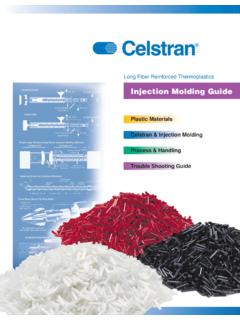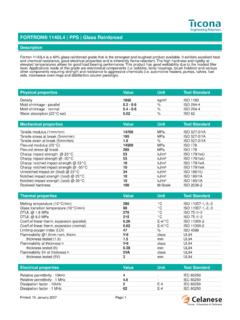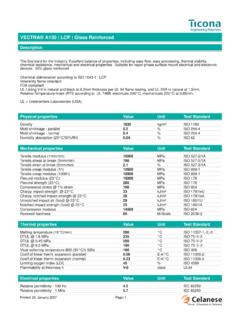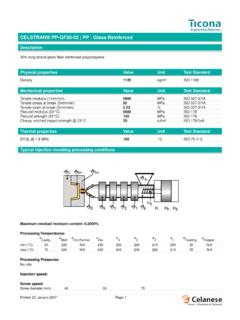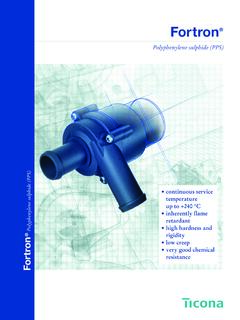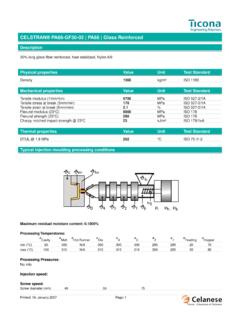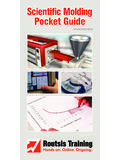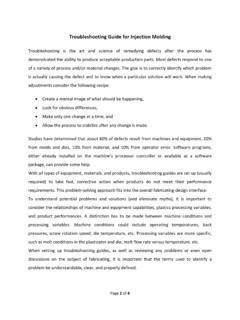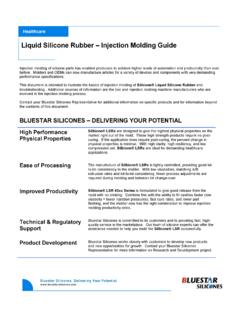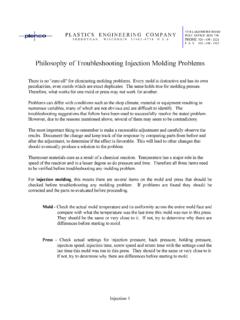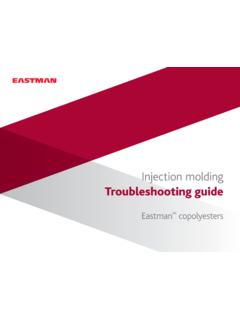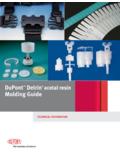Transcription of Celcon POM Processing and Troubleshooting Guide
1 Processing Celcon acetal copolymerCE-6 Processing Celcon acetal copolymerCelcon acetal copolymer1 ForewordThe Celcon Acetal Copolymer Processing and Troubleshooting Guide is written for plastics processors whorequire specific information on start-up, Processing techniques and Troubleshooting using this versatile group ofproducts. Material handling techniques, resin drying conditions and health and safety issues are also 1 and 2 cover an introduction to Celcon acetal copolymer grades and physical characteristics, regulatory and flammability listings, start-up and shutdown procedures, and the safety and health aspects pertaining to handling Celcon acetal copolymer.
2 This information is pertinent to all Processing methods. These two chapters should be read before attempting to process any grade of Celcon acetal 3 is devoted to the important topic of molded part dimensional stability, including part shrinkage, annealing, dimensional tolerances and the effect of moisture absorption on part dimensions. Each of the final four chapters of the manual describes a specific Processing technique: injection molding, extrusion, blow moldingand rotational casting, and includes a Troubleshooting section.
3 Information on machine settings, mold design, and(where appropriate) screw design is also more information on material characteristics and part and mold design, consult the following manuals: Celcon acetal copolymer Short Term Properties (CE-4), Designing with Plastic: The Fundamentals (TDM-1) and Designing with Celcon acetal copolymer (CE-10).They are available by contacting your local Ticona sales representative, by calling our Technical Information Hotline at 1-800-833-4882, or on our web site, and suggestions for improving this and other Ticona literature are always welcome, and may be sent tous at the above phone number, by writing to us at the address shown on the back cover or by e-mailing thewebmaster on our internet acetal copolymer2 Table of ContentsIntroduction1.
4 Of Acetal Codes and Agency Support82. General and and Health from Another from a Different Grade of13 Celcon Acetal of Surface Treatment143. Dimensional Caused by Processing 15(Injection Molding) Absorption184. Injection and Cavities and Surface Finish211234567 OverviewGeneralGuidelinesDimensionalStab ilityInjectionMoldingBlow MoldingExtrusionRotationalCastingCelcon acetal Cooling Parting Temperature Control Molding Surface Pressure Measurement28(CPM) Optimization.
5 Conducting a Design29of Experiments (DOE) Control of Molded of Molding Conditions on30 Mechanical Celcon Acetal Coupled Celcon Acetal in Blow Molding Blow Blow Head35 Celcon acetal of Process Variables on Part 38 Dimensional Stability and Part Strength396. of and Die Speed Tubing Rotational Drying Heating Oven Cooling MoldingExtrusionRotationalCastingCelcon acetal copolymer5 List of TablesTable Listings9 Table Start-Up Conditions12 Table of Remolding (Regrind) on the 13 Properties of Unreinforced Celcon AcetalTable of Remolding (Regrind)
6 On the 14 Properties of Glass-Coupled Celcon AcetalTable of Processing Conditions 15on Part ShrinkageTable Before and After Annealing17 Table Annealing Procedure18 Table Injection Molding Screw for 20 Plasticizing Celcon Acetal Copolymer Table Runner Size Recommendations 23for Celcon Acetal CopolymerTable Gate Dimensions for 24 Rectangular Edge GatesTable Start-Up Conditions28 Table Cycle Times as a Function 29of Wall Thickness Unreinforced GradesTable of Molding Conditions on 31 Mechanical Properties - Unreinforced GradesTable Molding Conditions for 32 Shrinkage Range - Unreinforced GradesTable Guide - Injection32 Molding Celcon Acetal CopolymerTable of Injection and Extrusion 35 Blow Molding ProcessesTable Screw Characteristics to Plasticize 36 Celcon Acetal Copolymer Blow MoldingTable Blow Molding Conditions37 Table Guide - Blow molding39 Table Metering Screw 42 Dimensions for Extruding Celcon AcetalTable Conditions for Tubing Extrusion43 Table Speed Tubing Extrusion 45 Troubleshooting Guide Table
7 Conditions for Film 46and Sheet ExtrusionTable and Sheet Troubleshooting Guide46 Table Extrusion Troubleshooting Guide 47 Table Casting Troubleshooting Guide49 Celcon acetal copolymer6 List of FiguresFig. of Molding Conditions and 16 Wall Thickness on Mold ShrinkageFig. due to Heat Aging for 17 Standard Melt Flow Grade of Celcon AcetalFig. Absorption by Unfilled Celcon 18 Acetal Under Various ConditionsFig. Changes due to Water 18 Absorption by Unfilled Celcon AcetalFig. Screw Profile for Injection 19 Molding Celcon AcetalFig.
8 Check Valve Design20 Fig. Molded-in Insert Designs24 Fig. Molded Moving Parts: Gear, 24 Cam and SpringFig. Basic Gate Designs Suitable 25for Celcon AcetalFig. Pin Divider to Promote Smooth 35 Flow and Avoid Weld LinesFig. Die with Adjustable Core 36 Pin for Control of Parison ThicknessFig. of Mold Temperature on Shrinkage38 Fig. of Cooling Time on Shrinkage38 Fig. of Blow Pressure on Shrinkage38 Fig. of Wall Thickness on Shrinkage38 Fig. Pinch-Off for Improved 39 Impact StrengthFig. Molded Fluidics Container39 Fig.
9 Metering Screw for Extrusion41 Fig. Post-Formed Profiles45 Fig. Molding Process481234567 OverviewGeneralGuidelinesDimensionalStab ilityInjectionMoldingBlow MoldingExtrusionRotationalCastingCelcon acetal copolymer71. Chemistry of Acetal Polymers Acetal polymers are chemically known aspolyoxymethylenes (POM). Two types of acetalpolymers are commercially available: Homopolymer is prepared by polymerizinganhydrous formaldehyde to form a polymercomposed of oxymethylene repeating units (-CH2O-). Acetal homopolymer products havesomewhat better short term mechanical propertiesthan the , including Celcon acetal copolymer, are prepared by copolymerizing trioxane (a cyclictrimer of formaldehyde) with a cyclic ether (usuallycontaining an ethoxy or other oxyalkylene group) toform a polymeric chain composed of oxymethylene (-CH2O-) and oxyethylene (-CH2-CH2-O-) orsimilar repeating units.
10 Copolymers have a widerprocessing window, better long term mechanicalproperties and superior chemical resistance comparedto homopolymers, and are inherently more stable andresistant to thermal degradation during service is because the randomly dispersed comonomerunits block polymer unzipping under thermalstress, or exposure to hot water or hot alkalinesolutions. Both the homopolymer and copolymer are end-capped, and also contain specific additives to preventirreversible thermo-oxidative depolymerization of the polymer backbone during General Characteristics Celcon acetal copolymer is a high strength, crystallineengineering thermoplastic material having an unusualand desirable balance of properties.
